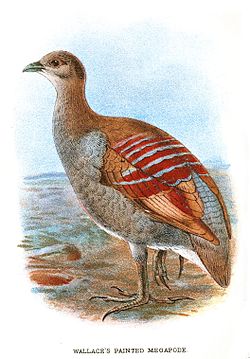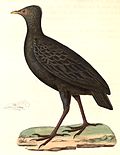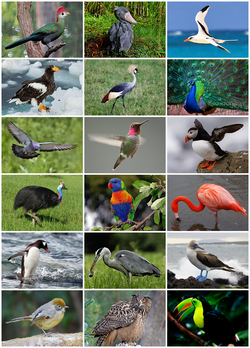The megapodes, also known as incubator birds or mound-builders, are stocky, medium-large, chicken-like birds with small heads and large feet in the family...
18 KB (1,677 words) - 11:34, 4 May 2025
The Moluccan megapode (Eulipoa wallacei), also known as Wallace's scrubfowl, Moluccan scrubfowl or painted megapode, is a small, approximately 31 cm long...
2 KB (213 words) - 17:51, 8 December 2024
The Tongan megapode (Megapodius pritchardii) is a species of bird in the megapode family, Megapodiidae, currently endemic to Tonga. The species is also...
5 KB (541 words) - 16:52, 23 October 2023
The Micronesian megapode or Micronesian scrubfowl (Megapodius laperouse) is an endangered megapode which inhabits islands of the Western Pacific Ocean...
6 KB (785 words) - 23:49, 31 March 2025
Nicobar megapode or Nicobar scrubfowl (Megapodius nicobariensis) is a megapode found in some of the Nicobar Islands (India). Like other megapode relatives...
14 KB (1,644 words) - 22:35, 14 January 2025
The Philippine megapode (Megapodius cumingii), also known as the Philippine scrubfowl or the Tabon scrubfowl, is a species of bird in the family Megapodiidae...
6 KB (528 words) - 19:18, 26 May 2025
The dusky megapode (Megapodius freycinet), also known as dusky scrubfowl or common megapode, is a medium-sized, approximately 41 cm (16 in) long, blackish...
3 KB (316 words) - 10:57, 8 September 2024
Orange-footed scrubfowl (redirect from Orange-footed Megapode)
(Megapodius reinwardt), also known as orange-footed megapode or just scrubfowl, is a small megapode of the family Megapodiidae native to many islands in...
5 KB (426 words) - 05:01, 14 March 2025
The Tanimbar megapode or Tanimbar scrubfowl (Megapodius tenimberensis) is a small megapode endemic to the Tanimbar Islands of Indonesia. It is sometimes...
2 KB (146 words) - 20:31, 11 January 2025
The Melanesian scrubfowl or Melanesian megapode (Megapodius eremita) is a megapode species that is endemic to islands within Melanesia. The Melanesian...
24 KB (2,806 words) - 16:51, 23 May 2025
The Kermadec megapode, also known as the Raoul Island scrubfowl (Megapodius sp. nov. 'Raoul Island'), was a population of land fowl that inhabited Raoul...
4 KB (471 words) - 21:39, 25 May 2025
Megavitiornis (redirect from Noble megapode)
only known species in the genus Megavitiornis. Originally thought to be a megapode, more recent morphological studies indicate a close relationship with Sylviornis...
4 KB (408 words) - 11:46, 31 December 2023
Progura is an extinct genus of megapode that was native to Australia. It was described from Plio-Pleistocene deposits at the Darling Downs and Chinchilla...
5 KB (544 words) - 11:51, 31 December 2023
Maleo (redirect from Mégapode Maléo)
The maleo (Macrocephalon maleo) is a large megapode and the only member of the monotypic genus Macrocephalon. The maleo is endemic to Sulawesi and the...
10 KB (1,237 words) - 09:20, 4 May 2025
The pile-builder megapode (Megapodius molistructor) is an extinct species of megapode. The subfossil remains were found by Jean-Christophe Balouet and...
3 KB (304 words) - 16:15, 28 November 2022
The Sula megapode or Sula scrubfowl (Megapodius bernsteinii) is a species of bird in the family Megapodiidae. It is found only in the Banggai and Sula...
5 KB (606 words) - 16:16, 30 December 2023
Brushturkey (section Megapodes)
brush-turkey or brush turkey generally refer to birds in three genera in the megapode family, and sometimes to other species such as the Australian bustard:...
1 KB (104 words) - 18:47, 4 July 2021
In all of the above, the name "scrubfowl" is sometimes exchanged with "megapode". Traditionally, most have been listed as subspecies of M. freycinet, but...
4 KB (231 words) - 14:42, 1 November 2024
among modern birds (but see below in regards to fossil groups and extant megapodes) is parental care for young after hatching. Jack Horner's 1978 discovery...
276 KB (28,233 words) - 22:24, 5 June 2025
Mwalau (redirect from Lini's megapode)
Mwalau walterlinii is an extinct species of megapode from Vanuatu, and the only species in the genus Mwalau. The holotype and only known specimen is from...
2 KB (149 words) - 08:50, 18 November 2024
The Vanuatu megapode or Vanuatu scrubfowl (Megapodius layardi) is a species of bird in the family Megapodiidae. It was formerly known as the New Hebrides...
3 KB (250 words) - 00:19, 11 August 2023
the Pacific Islands of Guam, Pohnpei and Palau Micronesian megapode, an endangered megapode which inhabits islands of the Western Pacific Ocean Micronesian...
2 KB (253 words) - 04:02, 24 September 2024
weight per day of incubation. The warmth for the incubation of the eggs of megapodes comes from the sun, decaying vegetation or volcanic sources. Incubation...
225 KB (23,631 words) - 21:50, 13 June 2025
Viti Levu scrubfowl (redirect from Lost Megapode)
(Megapodius amissus), also known as the Fiji scrubfowl or lost megapode, is an extinct megapode that was endemic to Fiji. The epithet amissus, from Latin "lost"...
2 KB (194 words) - 17:07, 15 December 2023
Biak scrubfowl (redirect from Biak Megapode)
The Biak scrubfowl or Biak megapode (Megapodius geelvinkianus) is a species of bird in the family Megapodiidae. It is found only on the islands of Biak...
2 KB (186 words) - 22:04, 28 August 2023
New Guinea scrubfowl (redirect from New Guinea Megapode)
The New Guinea scrubfowl or New Guinea megapode (Megapodius decollatus) is a species of bird in the family Megapodiidae. It is found in New Guinea, mostly...
1 KB (119 words) - 00:33, 19 March 2024
September; as many as 20 eggs are deposited at a time in an abandoned megapode nest or in a self-dug nesting hole. The eggs are incubated for seven to...
76 KB (8,649 words) - 17:41, 27 May 2025
Extremely precocial species are called "superprecocial". Examples are the megapode birds, which have full-flight feathers at hatching and which, in some species...
16 KB (1,942 words) - 14:25, 7 June 2025
allies, bettongs, potoroos, and rat kangaroos Macropodia, genus of crabs Megapode, chicken-like birds in the family Megapodiidae This disambiguation page...
506 bytes (86 words) - 01:05, 10 May 2025
athletic teams representing Southwestern College Mound-builder (bird), or megapode, birds in the family Megapodiidae Mound-building termites, a group of termite...
494 bytes (94 words) - 07:23, 31 March 2023





















